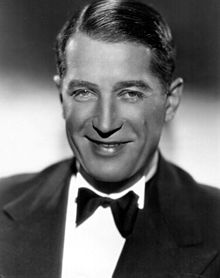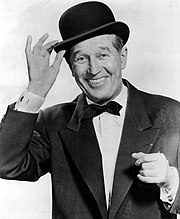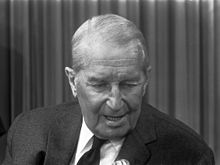Maurice Chevalier
From Wikipedia, the free encyclopedia
| Maurice Chevalier | |
|---|---|
 |
|
| Born | Maurice Auguste Chevalier September 12, 1888 Paris, France |
| Died | January 1, 1972 (aged 83) Paris, France |
| Occupation | Cabaret Singer, actor, dancer |
| Years active | 1908-1970 |
| Spouse(s) | Yvonne Vallée (1927-1933) (divorced) Nita Raya (1937-1946) |
Chevalier was born in Paris. He made his name as a star of musical comedy, appearing in public as a singer and dancer at an early age before working in four menial jobs as a teenager. In 1909, he became the partner of the biggest female star in France at the time, Fréhel. Although their relationship was brief, she secured him his first major engagement, as a mimic and a singer in l'Alcazar in Marseille, for which he received critical acclaim by French theatre critics. In 1917, he discovered jazz and ragtime and went to London, where he found new success at the Palace Theatre.
After this, he toured the United States, where he met the American composers George Gershwin and Irving Berlin and brought Dédé to Broadway in 1922. He also developed an interest in acting, and had success in the operetta Dédé. When talkies arrived, he went to Hollywood in 1928, where he played his first American role in Innocents of Paris. In 1930, he was nominated for the Academy Award for Best Actor for his roles in The Love Parade (1929) and The Big Pond (1930), which secured his first big American hit, Livin' in the Sunlight, Lovin' in the Moonlight.
In 1957, he appeared in Love in the Afternoon, which was his first Hollywood film in more than 20 years. In the early 1960s, he made eight films, including Can-Can in 1960 and Fanny the following year. In 1970, he made his final contribution to the film industry where he sang the title song of the Disney film The Aristocats. He died in Paris, on January 1, 1972, aged 83.
Contents
Early life
His father was a French house painter. His mother, Joséphine van den Bosch, was French of Belgian descent, .[1]He worked a number of jobs: a carpenter's apprentice, electrician, printer, and even as a doll painter. He started in show business in 1901. He was singing, unpaid, at a café when a member of the theatre saw him and suggested he try for a local musical. He got the part. Chevalier made a name as a mimic and a singer. His act in l'Alcazar in Marseille was so successful, he made a triumphant rearrival in Paris.
In 1909, he became the partner of the biggest female star in France, Fréhel. However, due to her alcoholism and drug addiction, their liaison ended in 1911. Chevalier then started a relationship with 36-year-old Mistinguett at the Folies Bergère, where he was her 23-year-old dance partner; they eventually played out a public romance.
World War I
When World War I broke out, Chevalier was in the middle of his national service, already in the front line, where he was wounded by shrapnel in the back in the first weeks of combat and was taken as a prisoner of war in Germany for two years. In 1916, he was released through the secret intervention of Mistinguett's admirer, King Alfonso XIII of Spain, the only king of a neutral country who was related to both the British and German royal families.In 1917, Chevalier became a star in le Casino de Paris and played before British soldiers and Americans. He discovered jazz and ragtime and started thinking about touring the United States. In the prison camp, he had studied English and had an advantage over other French artists. He went to London, where he found new success at the Palace Theatre, even though he still sang in French.
Hollywood
After the war, Chevalier went back to Paris and created several songs still known today, such as "Valentine" (1924). He played in a few pictures, including Chaplin's A Woman of Paris (a rare drama for Chaplin, in which his character of The Tramp does not appear) and made a huge impression in the operetta Dédé. He met the American composers George Gershwin and Irving Berlin and brought Dédé to Broadway in 1922. The same year he met Yvonne Vallée, a young dancer, who became his wife in 1927.When Douglas Fairbanks was on honeymoon in Paris in 1920, he offered him star billing with his new wife Mary Pickford, but Chevalier doubted his own talent for silent movies (his previous ones had largely failed).[2] When sound arrived, he made his Hollywood debut in 1928. He signed a contract with Paramount Pictures and played his first American role in Innocents of Paris. In 1930, he was nominated for the Academy Award for Best Actor for his roles in The Love Parade (1929) and The Big Pond (1930). The Big Pond gave Chevalier his first big American hit songs: "Livin' in the Sunlight, Lovin' in the Moonlight" with words and music by Al Lewis and Al Sherman, plus "A New Kind of Love" (or "The Nightingales").[3] He collaborated with film director Ernst Lubitsch. He appeared in Paramount's all-star revue film Paramount on Parade (1930).
While Chevalier was under contract with Paramount, his name was so recognized that his passport featured in the Marx Brothers film Monkey Business (1931). In this sequence, a little more than halfway through the film, each brother uses Chevalier's passport, and tries to sneak off the ocean liner where they were stowaways by claiming to be the singer—with unique renditions of "You Brought a New Kind of Love to Me" with its line "If the nightingales could sing like you". In 1931, Chevalier starred in a musical called The Smiling Lieutenant with Claudette Colbert and Miriam Hopkins. Despite the disdain audiences held for musicals in 1931,[4] it proved a successful film.[5]
In 1932, he starred with Jeanette MacDonald in Paramount's film musical, One Hour With You which became a success and one of the films instrumental in making musicals popular again. Due to its popularity, Paramount starred Maurice Chevalier in another musical called Love Me Tonight (also 1932), and again co-starring Jeanette MacDonald. It is about a tailor who falls in love with a princess when he goes to a castle to collect a debt and is mistaken for a baron. Featuring songs by Richard Rodgers and Lorenz Hart, it was directed by Rouben Mamoulian, who, with the help of the songwriters, was able to put into the score his ideas of the integrated musical (a musical which blends songs and dialogue so the songs advance the plot). It is considered one of the greatest film musicals of all time.[4]
In 1934, he starred in the first sound film of the Franz Lehár operetta The Merry Widow, one of his best-known films. In 1935, he signed with MGM and returned to France later that year.
During his years in Hollywood, Chevalier had a reputation as a penny-pincher. When filming at Paramount, he balked at parking his car in the Paramount lot at ten cents a day. After bargaining, he managed to get five cents per day. Another story is told of Chevalier (a smoker) having a conversation with someone who offered him a cigarette. He took it, said "Thank you", put it in his pocket, and continued with the conversation. But in Hollywood he seemed to be a divided character. When not playing around with young chorus-girls, he actually felt quite lonely, and sought the company of Adolphe Menjou and Charles Boyer, also French, but both much better educated than Chevalier. Boyer in particular introduced him to art galleries and good literature, and Chevalier would try to copy him as the man of taste. But at other times, he would 'revert to type' as the bitter and impoverished street-kid he basically was. When performing in English, he always put on a heavy French accent, although his normal spoken English was quite fluent and sounded more American.
In 1937, Chevalier married the dancer Nita Raya. He had several successes, such as his revue Paris en Joie in the Casino de Paris. A year later, he performed in Amours de Paris. His songs remained big hits, such as Prosper (1935), Ma Pomme (1936) and Ça fait d'excellents français (1939).
In 1957, Chevalier was awarded The George Eastman Award, given by George Eastman House for distinguished contribution to the art of film.
Maurice Chevalier (as well as French actor Charles Boyer, nicknamed "The French Lover") is also depicted in a Tex Avery cartoon.
World War II
During World War II, Chevalier kept performing for audiences. In 1941, he performed a new revue in the Casino de Paris: Bonjour Paris, which was another success. Songs like "Ça sent si bon la France" and "La Chanson du maçon" became hits. The Nazis asked Chevalier to perform in Berlin and sing for the collaborating radio station Radio Paris. He refused but did perform for prisoners of war in Germany at the camp where he was interned in World War I, and succeeded in liberating ten people in exchange.[6]In 1942 he returned to La Bocca, near Cannes, but returned to the capital city in September. In 1944 when Allied forces freed France, Chevalier was accused of collaborationism. Even though he was acquitted by a French convened court, the English-speaking press remained hostile and he was refused a visa for several years.[7]
After World War II
In his own country, however, he was still popular. In 1946, he split from Nita Ray and started writing his memoirs, which took many years to complete.He started to paint and collect and acted in Le silence est d'or (Man About Town) (1946) by René Clair. He still toured throughout the United States and other parts of the world and returned to France in 1948.
In 1944, he had already participated in a Communist demonstration in Paris. He was therefore even less popular in the U.S. during the McCarthyism period; in 1951, he was refused re-entry into the U.S. because he had signed the Stockholm Appeal.
In 1949, he performed in Stockholm in a Communist benefit against nuclear arms. Also in 1949, Chevalier was the subject of the first official roast at the New York Friars' Club, although celebrities had been informally "roasted" at banquets since 1910.[8]
In 1952, he bought a large property in Marnes-la-Coquette, near Paris, and named it "La Louque",[9] as a homage to his mother's nickname. He started a relationship in 1952 with Janie Michels, a young divorcee with three children. In 1954, after the McCarthy era abated Chevalier was welcomed back in the United States. His first full American tour was in 1955, with Vic Schoen as arranger and musical director. The Billy Wilder film Love in the Afternoon (1957) with Audrey Hepburn and Gary Cooper was his first Hollywood film in more than 20 years.[10]
Chevalier appeared in the movie musical Gigi (1958) with Leslie Caron and Hermione Gingold, with whom he shared the song "I Remember It Well", and several Walt Disney films. The success of Gigi prompted Hollywood to give him an Academy Honorary Award that year for achievements in entertainment. In 1957, he appeared as himself in an episode of The Jack Benny Program titled "Jack In Paris". He also appeared as himself in the 1958 Lucy Goes to Mexico television episode of The Lucy-Desi Comedy Hour.
Final years
In the early 1960s, he toured the United States and between 1960 and 1963 made eight films, including Can-Can (1960) with Frank Sinatra. In 1961, he starred in the drama Fanny with Leslie Caron and Charles Boyer, an updated version of Marcel Pagnol's "Marseilles Trilogy." In 1962, he filmed Panic Button; (not released until 1964); playing opposite blonde bombshell/sex symbol, Jayne Mansfield. In 1965, at 77, he made another world tour. In 1967 he toured in Latin America, again the US, Europe and Canada. The following year, on October 1, 1968, he announced his farewell tour.Historical newsreel footage of Chevalier appeared in the Marcel Ophüls documentary The Sorrow and the Pity. In a wartime short film near the end of the film's second part, he explained his disappearance during World War II (see the "World War II" section in this entry) as rumors of his death lingered at that time, and emphatically denies any collaboration with the Nazis. His theme song "Sweepin' the Clouds Away" from the film Paramount on Parade (1930) was one of its theme songs and was played in the end credits of the film's second part.
In 1970, several years after his retirement, songwriters Richard M. and Robert B. Sherman got him to sing the title song of the Disney film The Aristocats, which ended up being his final contribution to the film industry.
He died in Paris, on New Year's Day 1972, aged 83, and was interred in the cemetery of Marnes-la-Coquette in Hauts-de-Seine, outside Paris, France.
Chevalier has a star on the Hollywood Walk of Fame at 1651 Vine Street.
Famous songs
- "Madelon de la Victoire" (1918)
- "Dans la vie faut pas s'en faire" (1921)
- "Valentine" (1924)
- "Louise" (1929)
- "(Up On Top Of A Rainbow) Sweepin' The Clouds Away" (1930)
- "You Brought a New Kind of Love to Me" (1930)
- "Living In the Sunlight, Loving In the Moonlight" (1930)
- "Mimi" (1932)
- "Prosper (Yop La Boum)" (1935)
- "Quand un Vicomte" (1935)
- "Ma Pomme" (1936)
- "Le Chapeau de Zozo" (1936)
- "Mimile (un gars du Ménilmontant)" (1936)
- "Ça Fait d' Excellents Français" (1939)
- "Paris sera toujours Paris" (1939)
- "Ça sent si bon la France" (1941)
- "La Chanson du Maçon" (1941)
- "Notre Espoir" (1941)
- "Thank Heaven For Little Girls" (1957)
- "I Remember It Well" (1957)
- "Enjoy It!" (1967)
- "The Aristocats" (1970)
Selected filmography
- Playboy of Paris (1930)
- The Little Cafe (1931)
- Love Me Tonight (1932)
- The Beloved Vagabond (1936)
- Gigi (1958)




No comments:
Post a Comment
Please leave a comment-- or suggestions, particularly of topics and places you'd like to see covered